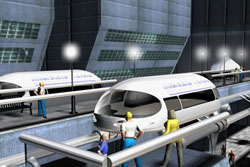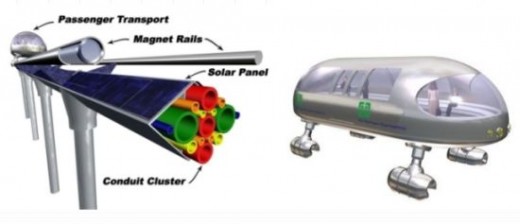In The Future, The Highway Runs On Solar Power

The Solar Powered Hydrogen Superhighway
Imagine a highway that is not over crowded, and not filled with pollution. Imagine people getting to places on time, without being stressed out and steaming mad. Imagine going places, while helping the environment at the same time. Imagine a mass transit system that can be installed throughout all major urban areas, at the lowest possible cost, with high quality and resilient materials that will be pollution free; this is the solar powered Hydrogen Superhighway.
How is this all possible?
The plan is already underway. It's being called the Interstate Traveler Project, and in 2003, it was unanimously resolved when presented to the House and Senate in Michigan.
Steel manufacturers will have a huge advantage, as over 750,000,000 tons of steel will need to be produced for this project, that will cover 54,000 miles of highway. The Superhighway cannot come soon enough, as approximately 2,160,000 people will benefit from full time jobs that are sure to come from this massive project.
How will this affect the environment?
The Hydrogen Superhighway, will actually be taking vehicles off of the road in great amounts, and will therefore greatly reduce the carbon dioxide placed in the air from daily driving. Once the project is fully operational, it is expected that the carbon dioxide within the air will be reduced by more than 60 million tons per year. This reduction will include cars, trucks, and even freight vehicles.
That's right, the Superhighway will serve multiple functions including; passenger transportation, freight transportation, medical transportation, vehicle transportation, as well as other various forms of transportation.

How does it work?
How can a project like this become operational strictly from the use of alternative energy?
I'm glad you asked. The Superhighway rails are actually lined with solar panels that will provide all of the energy needed for; transportation, communications, security, water, and even sewer. Inside the central support beam of the maglev system, is a conduit cluster that can be used to transport any liquid and vapor based material.
Thousands of transport vehicles on the Superhighway will also be able to produce and supply hydrogen fuel and electrical energy.
The suspesion system built into the transport vehicles will enable them to adapt to G-forces on the fly, making the ride as quick and smooth as possible, while using less energy to propel the vehicle.
The Superhighway will meet all of the safety regulations, meaning that it will not be easily damaged by weather systems and natural disasters.
Is this Superhighway feasible?
Other advantages
With thousands of potential transport vehicles on the Superhighway, not only will people be able to get places without much hassle, but evacuations from areas affected by natural disasters should also be much easier.
There will also be fleet services for public sporting events, as well as other public events. Medical transports will also be available, allowing people to receive quick emergency help. Some transport vehicles may also be used for business use, providing restaurant services on the Superhighway itself.
As mentioned before, transports will not only be able to transport people, but cargo and vehicles as well.
The Hydrogen Superhighway has many obvious advantages:
Creation of good full time jobs
Carbon dioxide in the air is greatly reduced
Runs on solar power
Upgrades the existing infrastructure currently in use
Quick and easy public transportation
Medical transportation
Cargo transportation
Quick evacuation possibilities
Creates hydrogen for fuel, as well as electric energy
For more information regarding this project visit: http://interstatetraveler.us









